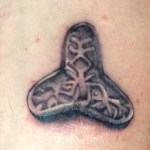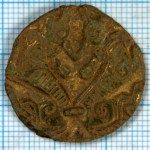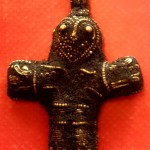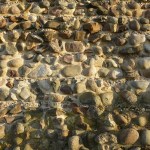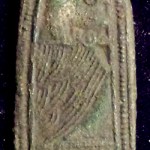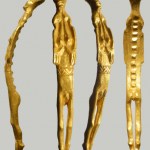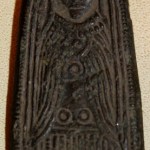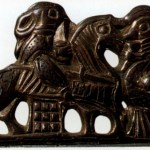Denmark
I recently received a long-awaited verdict on an official complaint I had filed: there was in fact nothing formally wrong with the decision by the Dept of Historical Studies in Gothenburg to hire Zeppo Begonia. Since the verdict didn't go my way, as planned I am now turning my back on academic archaeology. The reason is that qualifications don't count in Scandyland.
Being friends with people inside, and preferably being a local product, is what gets you academic jobs here. I need to cut my losses and move on. I would call this post a burning of bridges if there were any to burn, but there are…
René Lund Klee's tattoo
In our series of metal detectorist tattoos, where people put pictures of their best finds on themselves -- usually on their detector arms -- we now pay a visit to René Lund Klee. His tattoo depicts an Urnes brooch that he found on the Danish island of Lolland. The needlework was done there by Sandra's Ink in Nakskov.
Urnes brooch from Lolland
The Urnes style of c. AD 1050-1125 forms the end of the Scandinavian animal art tradition, which produced astonishing artistic riches during the Late Iron Age (c. 375-1125). Named for a Norwegian wooden church from the 1070s…
Jan Mortensen's tattoo
Another metal detectorist tattoo! This time it's Jan Mortensen who has decorated the arm with which he brandishes the detector. The object is a 10th century trefoil brooch that Jan found in Holbæk municipality, northern Zealand. Hugo Tattoo in Holbæk did the needlework.
Trefoil brooches were worn by South Scandinavian women as a third brooch, to close their cloaks. But the overall shape descended from high-end acanthus-decorated silver mounts for the bandoliers worn by Charlemagne's vassals around AD 800. Their trefoils joined the strap from the scabbard to the…
Torben Thomsen's tattoo
Torben Thomsen found this relief-decorated and gilded pendant in Hjørring municipality, northernmost Jutland. It was his first really old piece. Knight Ink Tattoo in Frederikshavn did the tattoo work on Torben's lower left leg. Torben's pendant is missing its loop, but his workmate Daniel Bach Morville has found the complete piece below at a nearby site.
The motif is a pair of antithetical sea horses. To date them, let's look at the animal art -- the two objects, not the tattoo. The tattoo artist has classicised the motif and gotten rid of a lot of specifically…
Metal detectorist Dennis Fabricius Holm made a pretty sweet find yesterday: the third known Birka crucifix.
These little wonders of 10th century goldsmith work are named for the first find, made in 1879 when Hjalmar Stolpe excavated in the cemeteries of Birka near Stockholm. In addition to the crucifix grave 660 contained, among other things, two other fine silver filigree pendants and a bronze-capped iron wand that may have served pagan religious purposes.
Crucifix from grave 660 at Birka, Uppland, Sweden.
In 2012 Silke Eisenschmidt identified fragments of a second Birka crucifix among…
In countries with a big metal detector hobby, the stereotypical participant is an anorak-wearing, rural, poorly educated, underemployed male. I don't know how true this cliché image is. But apart from the anorak, it's certainly an accurate description of the core voter demographic behind the rise of racist right-wing populist parties. These people have trouble finding jobs, and they have trouble seeing through the racist propaganda that tells them they would have jobs and girlfriends if it weren't for the bloody furriners.
I'm known as a detectorist-friendly archaeologist. I've made many…
I spent last week in Denmark at a friendly, informative and rather unusual conference. The thirteenth Castella Maris Baltici conference (“castles of the Baltic Sea”) was a moveable feast. In five days we slept in three different towns on Zealand and Funen and spent a sum of only two days presenting our research indoors. The rest of the time we rode a bus around the area and looked at castle sites and at fortifications, secular buildings, churches and a monastery in four towns. Our Danish hosts had planned all of this so well that the schedule never broke down. Add to this that the food and…
Guldgubbar are tiny pieces of gold foil with (usually) embossed motifs. They most commonly depict single men, then embracing couples, then single women, all in fine clothing. They date from the Vendel Period (540-790) and seem to have been religious artefacts. Usually they are found in the remains of elite residences, concentrating in and around roof-bearing postholes in the main hall. They form this gold-poor period's continuation of the Migration Period's gold bractate pendants and other sumptuous goldwork.
Gold foil figures weren't necessarily made where they are found. They are eminently…
Smørenge is one of the sites on Bornholm that keeps yielding mid-1st-millennium gold mini-figurines. But in addition to the 2D representations on embossed gold foil known as guldgubber, an artisan employed by the magnate family at Smørenge also made nude 3D figurines. The fifth of these was found by one of the island's famously skilful metal detectorists in May, and she's quite a revelation. Because representations of women are far less common than of men in Iron Age art, and nude women are almost unknown.
The Smørenge woman is wearing only a hatched belt. She has the prominent "seer's thumbs…
Another one of the rare production dies for 6/7/8th century gold foil figures has come to light, again on Zealand! This is an unusual design depicting a lady from the front. She's wearing a long dress, a cloak and two bead strings. She seems to be cupping her hands around a ring at her abdomen. The rings on her dress hem are quite odd. Parallels to the general motif and design are known from Eketorp on Öland (a foil) and Sättuna in Östergötland (a die). Congratulations to detectorist Hans, and thanks for doing other folks with an interest in the past a big favour!
Update 4 Feb: Aard regular…
When I was an undergrad in 1990 we were taught that all six periods of the Scandinavian Bronze Age were 200 (or in one case 300) years long. The most recent radiocarbon work shows that they all had different lengths and were more likely 130-280 years long. And the periods with the most abundant metalwork finds, II and V, are the two shortest. So their previously known status as metal-rich eras looks even more pronounced now, and the intervening periods look even poorer.
Per. I. 1700-1500 cal BC (200 yrs)
Per. II. 1500-1330 (170 yrs)
Per. III. 1330-1100 (230 yrs)
Per. IV. 1100-950/20 (165 yrs…
Most prosperous countries have legislation for what kinds of archaeological finds a citizen has to hand in to the authorities. In Denmark, still using a Medieval term, such finds are termed danefae, "property of the dead". And here is Danish TV4's list of the top-10 such finds of 2012. All but one of them have been handed in by detectorists, and two by Swedish detectorists operating in Denmark because of Sweden's restrictive rules!
It wouldn't really be worthwhile to make a top-10 like this for Sweden, as the pretty gold & silver metalwork they concentrate on in the program is usually…
Etymologically speaking, ”valkyrie” means ”chooser of the slain”. The job of these supernatural shield maidens in Norse mythology is to select who dies on the battlefield and guide their souls to Odin's manor, where they will spend the afterlife training for the Twilight of the Gods, the final battle against the forces of chaos. After each day's combat training, a mead-hall party with drink and reincarnated pork ensues, with the valkyries waiting the tables.
We have had very few period depictions of armed women. Instead scholars have applied the term “valkyrie” to a common Late Iron Age motif…
A few weeks ago my friend Tobias Bondesson and his fellow amateur detectorists Iohannes M. Sundberg and Tommy Olesen found a 3.5 kg silver and gold hoard from the 5th century AD near Roskilde in Denmark. They reported their find to the town museum, the hoard was lifted by experts and excavations are ongoing. This closed find, consisting of ~1500 pieces of metal and the pot in which they were buried, is of immense value to archaeology and numismatics thanks to the snapshot of coeval objects it gives us. This not just bullion: many of the objects are typologically distinct. I'd love to help…
Yesterday I went to Jutish Viborg by train, plane and bus. This took a bit less than eight hours. Exiting Aalborg airport into the icy sleet I managed to walk straight into the glass wind breaker outside the turnstile, banging my forehead and knee. Everybody around studiously avoided noticing my antics. On arriving in Viborg I found the museum, met some colleagues and received a key for the visiting scholars' building at Asmild that I'm staying in. Then to the city library where there is warmth and (flaky) wifi, and where I am now sitting again. Wednesday ended in good company with…
Here's a cool new detector find from Hvirring in central Jutland, Denmark. I've never seen a piece like this before: measuring only 45 mm in length, it must be a top mount for something - box, horse yoke, staff? But the motif, four dancing gripping beasts, and the style they're executed in, place the thing firmly in the 9th century. Note the little round ears and the cross-hatching on chest and rump.
Thanks to Dear Reader Jakob for the tip-off.
Here's a quick look at the most recent windfall of popular archaeomags that has reached my big black mailbox. I've decided to terminate a few of the complimentary subscriptions, so these rundowns will be shorter and/or less frequent in the future. If you want, Dear Reader, you can check back at the five instalments I've written since late December: 23 Dec - 27 Jan - 15 March - 30 April - 14 June.
To me, the high point of Archaeology Southwest #25:2 (spring '11) are two aerial photographs of the Gran Quivira / San Buenaventura mission pueblo in central New Mexico (pp. 6-7). Here is a major…
Since the autumn of 2009, I've spent most of my research efforts studying sacrificial finds in the Bronze Age local landscape. I was thus pleasantly surprised (though a little disappointed because I missed the whole thing) when I learned that there had been a symposium on the theme "Sacrificial finds in the Late Bronze Age local landscape" at the museum in Viborg, Jutland, in March last year. Recently, only about a year after the event, a fine proceedings volume (104 pp., A4 format, 2-column text, colour printing) was published, and I was kindly sent a copy for review here on Aard.
The volume…
Skalk's first issue for 2011 opens with a great article by Mr. Bronze Age Religion himself, Flemming Kaul. It deals with two wooden votive helmets found in a bog on Lolland in Denmark. Their closest parallels are from a big multiperiod deposit of pre-Roman metal helmets found at Negova/Negau in Slovenia. One of the latter carries an extremely early inscription in Germanic, the name Harigasti, which makes the link to the Uglemose find even more interesting.
Kaul shows further parallels from coeval situla art where boxers compete for similar helmets. And then comes a passage that made me laugh…
My detectorist friend Svante Tibell pointed me to an extremely interesting term paper by Ingrid Ulst, one of Marge Konsa's students at the university of Tartu in Estonia. The title says it all: The Regulation of Metal Detectors and Responsible Metal-Detecting: the Examples of the UK, Sweden and Denmark. Check it out!

